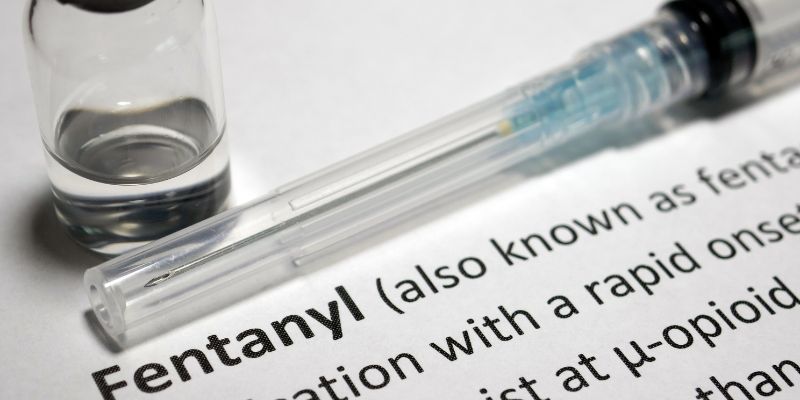
In the relentless pursuit of success, many individuals, including employees of various organizations, find themselves grappling with the dark shadow of addiction. As a male business coach from Tennessee, I, Gordon Grigg, have witnessed first-hand the devastating impact of substance dependence, particularly fentanyl addiction, on individuals and their family members. Fentanyl, a potent opioid originally developed for pain management, has clandestinely infiltrated the streets, often masquerading in different forms, from small candies to counterfeit oxycodone pills. This insidious drug, exponentially more powerful than heroin, is a silent poison, claiming lives at an alarming rate.
As we navigate through a sea of sensitive information available on various official government organization websites and secure .gov domains, the sheer magnitude of this crisis becomes evident.
Escalating Opioid Crisis: Understanding the Devastating Impact of Fentanyl Through DEA Statistics, CDC Data, and NIDA Insights and Personal Stories
- DEA Statistics on Fentanyl Seizures (2023): The DEA reports a significant increase in fentanyl seizures, highlighting the drug’s prevalence. In 2022, over 59.6 million fentanyl-laced fake pills and more than 13,300 pounds of fentanyl powder were seized. These numbers equated to over 397 million lethal doses. In 2023, the seizures accounted for over 360 million deadly doses, with a record 74.5 million fentanyl pills seized, indicating the escalating presence of this drug.
- CDC Data on Fentanyl Overdoses (2016-2021): The CDC’s National Center for Health Statistics reports that drug overdose death rates involving fentanyl increased by 279% from 5.7 per 100,000 in 2016 to 21.6 in 2021. In 2021, the overdose death rate involving fentanyl was 21.6 per 100,000, a 24% increase from the previous year. The rates were highest among males and in certain age groups, emphasizing the widespread impact of fentanyl abuse.
- NIDA Insights on Fentanyl Addiction: The National Institute on Drug Abuse (NIDA) identifies fentanyl as a powerful synthetic opioid, originally FDA-approved for treating severe pain. However, illicitly manufactured fentanyl and similar synthetic opioids have increasingly infiltrated the drug supply, contributing to a dramatic rise in drug overdose deaths in the U.S. Fentanyl, being 50 to 100 times more potent than morphine, poses a high overdose risk, especially when unknowingly consumed in contaminated or counterfeit drugs. NIDA’s efforts focus on understanding, preventing, and responding to the public health impacts of fentanyl, including developing effective prevention, treatment, and harm reduction strategies.
- Personal stories: The struggles of people like Alejandro, John, and Jessica to overcome their fentanyl addiction shed light on the difficult process of doing so. Their narratives, shared by the USC Center for Health Journalism, provide a raw and intimate look at the complexities and challenges of breaking free from the clutches of addiction.
Alejandro, 41, from Pacoima: Alejandro’s life was profoundly affected by opioids from a young age, growing up in an environment where heroin and pain pills were commonplace. His addiction to fentanyl began with what he believed were oxycontin pills, which he later realized were laced with fentanyl. The drug led him to homelessness and a daily struggle to “get well.” Despite the hardships of street life, including the constant need to avoid withdrawal symptoms, Alejandro is motivated to reclaim a better life, though he acknowledges the profound changes addiction has wrought upon him.
John, 32, from Antelope Valley, CA: Living in a temporary housing shelter, John follows a routine dominated by his addiction. His struggle began with heroin and escalated after he tried fentanyl. Despite his desire to quit and dreams of working in the music industry, he finds himself trapped in a cycle of drug use, hindered by the challenges of finding permanent housing and the pervasive influence of his environment on his addiction. John’s story is a testament to the deep hold that fentanyl can have on a person’s life, stunting personal growth and hindering efforts to move forward.
Jessica, 34, from Saint Paul, Minnesota: Jessica’s experience with fentanyl addiction is marked by years of homelessness and the constant pursuit of the drug to avoid painful withdrawals. Her life on the streets has been a harrowing journey of survival, marred by overdoses and physical health challenges. Despite the difficulties, she finds moments of solace in simple pleasures like painting her eyelashes and enjoying conversations. Jessica’s story highlights the extreme challenges faced by those caught in the grip of fentanyl addiction, especially when compounded by issues like homelessness and lack of access to resources.
These stories underline the multifaceted nature of addiction—it’s not just about the drug but also about the circumstances, mental health issues, and societal challenges that individuals face. The path to recovery is fraught with obstacles, but the resilience and determination exhibited by Alejandro, John, and Jessica offer a ray of hope. Their experiences remind us of the importance of empathy, support, and comprehensive rehabilitation programs in the fight against fentanyl addiction.
Addressing fentanyl addiction requires a concerted effort from all stakeholders, including sponsors of employee wellness programs. It is not just a personal struggle; it’s a societal menace that needs to be tackled with education, support, and empathy. This article aims to shed light on this issue, offering a beacon of hope to those ensnared by the clutches of this lethal addiction.
The Growing Menace of Fentanyl: A Look at the Statistics
Deadly Nature of Fentanyl: Recent data reveals that over 100,000 overdose deaths in a 12-month period in the U.S. involved synthetic opioids, primarily illicitly manufactured fentanyl, marking a stark increase from previous years (National Institute on Drug Abuse).
Rising Overdose Rates Among Youth: The opioid crisis, especially involving fentanyl, is worsening. In 2021, the U.S. reported 80,411 opioid overdose deaths, a significant increase that highlights this growing epidemic. Fentanyl, often mixed with other drugs, poses a substantial risk to users, particularly the youth
Challenges in Detecting Fentanyl: The insidious nature of fentanyl lies in its invisibility in drugs, making it a silent killer. Fentanyl test strips, though useful, might not detect more potent variants like carfentanil, making it extremely risky for unsuspecting users. This highlights the need for heightened awareness and caution
Impact on Different Demographics: Fentanyl’s impact is widespread, affecting various demographics at alarming rates. Non-Hispanic Blacks, for instance, face the highest mortality rate due to synthetic opioids other than methadone. The surge in overdose deaths across different ethnic groups underscores the pervasive nature of the fentanyl crisis
Recognizing Signs of Fentanyl Overdose: Identifying a fentanyl overdose can be life-saving. Symptoms include pinpoint pupils, unconsciousness, weak breathing, and clammy skin. Immediate action, such as calling 911 and administering naloxone, is critical in such scenarios
These statistics and insights into the dangers of fentanyl underscore the urgent need for increased public awareness and education on the risks associated with this potent opioid.
The Reality of Fentanyl Addiction

Fentanyl addiction is a severe and often life-threatening condition. As a synthetic opioid, it elicits a powerful euphoric effect, making it highly addictive. Individuals who abuse fentanyl are at a higher risk of opioid overdose, which can result in a limp body, clammy skin, pinpoint pupils, and, in severe cases, coma or death. The abuse of fentanyl not only affects the physical health of the individual but also takes a toll on their mental well-being, relationships, and overall quality of life. Overcoming fentanyl addiction requires comprehensive support services, including medical intervention, counseling, and rehabilitation programs.
How Fentanyl Changes Lives
Fentanyl is a potent drug that can have far-reaching consequences on the lives of those who use it and their loved ones. While prescribed fentanyl under medical supervision can be an effective pain management tool, its misuse and abuse can lead to dire outcomes. Obtaining fentanyl illicitly increases the risk of overdose, even in small doses. Misuse often causes individuals to prioritize drug use over their responsibilities, leading to tense personal and professional relationships.
That is why there is a need for increased public education on the dangers of fentanyl misuse and abuse. Many people may not realize the risks involved or may not understand how easily they can become addicted to this powerful substance. Implementing educational campaigns that highlight the dangers of fentanyl can help increase awareness and prevent addiction before it takes hold. Additionally, providing resources for those struggling with addiction is crucial in helping them overcome this debilitating disease.
Consider the case of John, a dedicated employee at a tech firm whose descent into addiction began with a prescription of oxycodone and spiraled into a fentanyl dependency. Initially prescribed oxycodone for chronic back pain, John found himself increasingly reliant on the medication. Over time, his tolerance grew, leading him to seek stronger alternatives, eventually turning to fentanyl for its potent effects. As his dependency deepened, John began to experience a host of debilitating symptoms: intense cravings, mood swings, and severe withdrawal symptoms, including nausea, muscle aches, agitation, and insomnia. These symptoms impacted not only his physical health but also his mental well-being, job performance, and relationships as he struggled to maintain his professional responsibilities while battling the overpowering grip of addiction.
What is The Science behind Fentanyl Addiction?
To understand the complexities of fentanyl addiction, it is necessary to examine the science behind its addictive properties. Fentanyl addiction involves changes in the brain, which result in dependence and cravings for the drug. Moreover, the risk of overdose is significantly heightened due to fentanyl’s potency. By unraveling the underlying mechanisms of addiction, we can develop effective strategies for prevention, intervention, and long-term recovery.
Fentanyl’s Effect on the Brain

Fentanyl, like other opioids, acts on the brain’s opioid receptors, producing pain relief and a sense of euphoria. Regular use of fentanyl alters the brain’s chemistry, leading to addiction and dependence. With continued use, the brain becomes accustomed to the presence of fentanyl, requiring higher doses to achieve the same effects. This cycle of dependence and tolerance reinforces addictive behaviors, making it challenging to break free from the grip of fentanyl addiction. Understanding the neurological implications of fentanyl use is crucial to addressing the addiction crisis and providing effective treatment options.
The Progression of Use to Addiction
The journey to fentanyl addiction often starts with legitimate use for severe pain. It can then progress to abuse of pharmaceutical fentanyl or its analogs obtained from the drug market. The dangers of fentanyl abuse include pinpoint pupils, clammy skin, and vomiting.
The progression from experimental fentanyl use to addiction involves physiological and psychological changes. Recognizing usage patterns can aid in addiction prevention efforts and targeted interventions. Understanding this transition is crucial for effective prevention strategies and interventions.
The Risk of Overdose
One of the most severe risks associated with fentanyl addiction is the possibility of overdosing, which can be life-threatening. Fentanyl’s potency increases the risk of overdose deaths, even with small doses. Some of the signs of a fentanyl overdose include a limp body, clammy skin, pinpoint pupils, and respiratory depression. It is important to recognize the symptoms of overdose and act swiftly by seeking medical assistance and, if available, administering naloxone, a drug that can reverse the effects of opioid overdose. Prompt intervention can save lives and prevent long-term health complications.
Options for Overcoming Fentanyl Addiction

The fentanyl crisis has emerged as a formidable challenge to public health. Characterized by high addiction and overdose rates, fentanyl addiction requires a multifaceted approach for effective treatment and recovery.
Medical Treatments Key to combating fentanyl addiction are FDA-approved medications such as methadone, buprenorphine, and naltrexone. These medications aid in reducing cravings and withdrawal symptoms, playing a crucial role in the recovery process. For more information, the Substance Abuse and Mental Health Services Administration (SAMHSA) provides comprehensive resources.
Behavioral Therapies Behavioral therapies, including cognitive-behavioral therapy (CBT) and contingency management, are instrumental in addressing the psychological aspects of addiction. These therapies help individuals modify their thinking and behavior related to drug use. The National Institute on Drug Abuse (NIDA) offers in-depth insights into these therapeutic approaches.
Support Groups Support groups like Narcotics Anonymous provide essential peer support, fostering a sense of community and shared experience. This mutual support is a cornerstone of long-term recovery. Further information is available on the Narcotics Anonymous website
Rehabilitation Programs Both inpatient and outpatient rehabilitation programs offer structured treatment environments. These programs focus on detoxification, therapy, and preparing individuals for life after addiction. The American Addiction Centers provide details about these programs.
Lifestyle Changes and Holistic Approaches Recovery also involves lifestyle changes, including improved nutrition and regular exercise. Holistic approaches such as acupuncture and yoga can complement traditional treatments.
Relapse Prevention Preventing relapse is a critical component of long-term recovery from fentanyl addiction. A robust support system acts as a pillar of strength, while ongoing therapy and counseling provide the tools for emotional and mental fortitude. Recognizing and managing triggers, coupled with practical coping mechanisms, form a defensive barrier against potential relapse. Aftercare programs and support groups offer a sense of community and understanding, which are invaluable in maintaining sobriety. Furthermore, the incorporation of healthy habits and routines into daily life lays the groundwork for a balanced and healthy future, free from the chains of addiction.
Life after Fentanyl Addiction: A Path to Renewal

Recovery from fentanyl addiction marks the beginning of a challenging yet transformative journey. In the United States, the pervasive pain of drug abuse touches countless lives, painting a somber picture of the opioid crisis. Health professionals and first responders are on the frontlines, not only saving lives but also guiding survivors toward crucial recovery services. Despite ongoing efforts, the danger of fentanyl and counterfeit pills remains a menacing presence in the drug market, underscoring the ongoing battle against this epidemic. In this arduous journey towards healing, the role of family support emerges as a beacon of hope and strength, providing the emotional bedrock needed for recovery.
Long-term Effects and Coping Mechanisms: Beyond the Addiction
The shadow of fentanyl addiction lingers long after the substance is out of the system. Managing chronic pain, often a fallout of long-term opioid use, becomes a central focus in the lives of those in recovery. Developing positive coping strategies is not just beneficial but essential for enduring wellness. Mental health, frequently entangled with the web of addiction, demands attention and care. Addressing psychological scars and mental health concerns is as vital as treating the physical remnants of addiction.
Rebuilding Life Post-Addiction: A Holistic Approach
Emerging from the clutches of fentanyl addiction, individuals find themselves at a critical juncture where reintegrating into the community becomes paramount. Supportive measures like transitional housing, legal aid, and vocational training are not just aids but necessities on the path to normalcy. These resources, combined with holistic wellness programs, play a pivotal role in nurturing the physical, mental, and emotional well-being of recovering individuals. This comprehensive approach to rehabilitation lays the foundation for a sustainable and fulfilling life post-addiction.
Personal Stories of Triumph over Fentanyl Addiction: Voices of Hope

Although the path to overcoming fentanyl addiction is difficult, it is also characterized by inspiring tales of tenacity and success. Sharing these personal narratives serves a dual purpose: inspiring hope in those still struggling and fostering deeper empathy within the broader community. Celebrating each milestone in the recovery process not only bolsters the spirits of those in recovery but also empowers and solidifies the support network that surrounds them.
- Britton’s Story: Britton’s journey into opioid addiction began at age 19, following a severe shoulder injury sustained while serving in the U.S. Army. His struggles were compounded by his then-wife’s substance use and his interactions with fellow veterans who misused prescription opioids. Over 11 years, Britton faced immense challenges, including the loss of his wife, complications from drug use, and losing custody of his children. His turning point came in 2018 when he was arrested and referred to the Veterans Treatment Court. This program, providing structured therapy, played a pivotal role in his recovery. Today, Britton is remarried, raising his children, and aspiring to accomplish his personal and professional goals. His story is a reminder that recovery is possible and that there is light at the end of the tunnel.
- Tele’s Story: Tele started misusing prescription opioids in high school, seeking to numb his emotional pain. Despite his outward success in academics and sports, he struggled with anxiety, depression, and the inability to share his sexual identity. His addiction escalated to heroin use, leading to a life-altering car crash and subsequent arrest. Tele’s journey to recovery began when he sought treatment for his substance use disorder. With the support of his parents and friends, Tele has been in recovery for four years, enjoying clarity and happiness. His story highlights the importance of support systems in overcoming addiction and reducing the stigma associated with opioid use disorder.
- Tessa’s Story: Tessa’s addiction to prescription opioids began in high school following a sports injury. By age 28, she was using heroin and continued to use opioids throughout her pregnancies, leading to her children experiencing withdrawal symptoms. Arrests and the loss of custody of her children were hallmarks of her life. After multiple treatment attempts and relapses, Tessa reached a turning point and has been in recovery for three years. Today, she runs a treatment center focused on supporting pregnant women with substance use disorders, sharing her story to help others realize that recovery is achievable.
- Trevor’s Story: Trevor’s descent into addiction started casually with pill abuse at age 18, escalating to fentanyl use after a stressful breakup. The intense withdrawals made him realize his addiction. Struggling to cope with his classes, he decided to seek help. Rehabilitation was challenging, but Trevor eventually gained control over his addiction, offering hope to others facing similar struggles.
- Kate’s Story: As a nurse and a mother, Kate faced her son’s fentanyl addiction firsthand. Her son had struggled with drug use since his early teens, but it seemed like he had turned a corner after starting his job. However, a fentanyl overdose, which Kate managed to reverse with Narcan, revealed the ongoing struggle. Her son’s experience underscores the dangerous allure of fentanyl, even for long-time drug users, and highlights the crucial role of the family in navigating the path to rehabilitation.
- Stanley’s Story: Stanley’s story is one of close encounters with death due to fentanyl use and the transformative power of support and rehabilitation. Resistant to rehab initially, Stanley’s experience in detox and therapy helped him redefine his life choices. The support from his girlfriend and family played a significant role in his recovery, showing the importance of a strong support network in overcoming addiction and making better life choices.
Each of these stories illuminates the diverse paths that lead to and from addiction, underscoring the complexities of opioid dependency and the multifaceted approaches required for successful recovery. They offer a poignant reminder of the resilience of the human spirit and the power of support, treatment, and hope in overcoming the grip of addiction.
Conclusion
In conclusion, overcoming fentanyl addiction is a challenging journey that requires support, determination, and professional help. Understanding the impact of fentanyl, both on the brain and in terms of the risk of overdose, is crucial in comprehending the severity of this addiction. The path to addiction is often paved with various factors, but with the right treatment methods and a strong support system, recovery is possible. Life after fentanyl addiction involves addressing the long-term effects and developing coping mechanisms to rebuild one’s life. Personal stories of triumph inspire us and remind us that there is hope for a brighter future. While there is no foolproof strategy to prevent relapse, staying connected to support networks and implementing healthy coping mechanisms can greatly reduce the risk.
Each person’s path to recovery is unique, and developing a personalized treatment plan is essential. Seeking help is the first step towards reclaiming control and leading a healthier, more fulfilling life.


